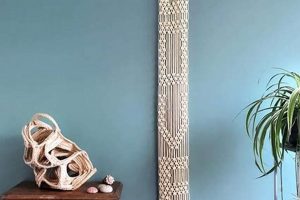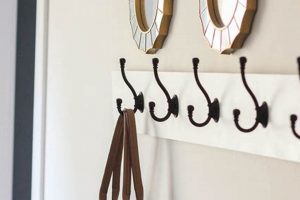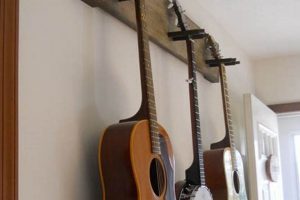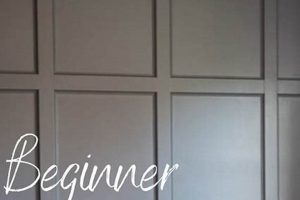A self-assembled floral backdrop, frequently employed for aesthetic enhancement, involves the construction of a decorative panel adorned with artificial or natural blossoms. The process typically includes selecting a base material, attaching flowers using adhesive or mechanical fasteners, and arranging the floral elements to achieve a desired visual effect. For example, one might construct a panel for a wedding photo booth or as a permanent art installation in a residential setting.
The practice offers a cost-effective alternative to professionally designed floral arrangements, while providing a personalized and visually appealing element for events or interior spaces. Historically, individuals have customized their surroundings with natural elements, reflecting a desire to connect with the environment and express individual creativity. This approach allows for adaptable design choices, facilitating modifications to suit changing aesthetic preferences and budgetary constraints.
The following sections will delve into specific materials suitable for floral backdrops, various assembly methods, design considerations for achieving optimal visual impact, and best practices for maintenance and preservation of these constructed elements. Additionally, we will examine resources available for sourcing necessary components and offer guidance on troubleshooting common construction challenges.
Tips for Floral Backdrop Construction
The subsequent guidance aims to optimize the creation process, ensuring a visually appealing and structurally sound finished product. Adherence to these recommendations can minimize errors and maximize the longevity of the assembled floral display.
Tip 1: Material Selection: Prioritize selecting a backing material appropriate for the intended environment. For outdoor installations, weather-resistant materials such as treated wood or durable plastics are advised. For indoor use, lighter materials like foam board or fabric stretched over a frame may be suitable.
Tip 2: Floral Component Assessment: Before beginning assembly, meticulously inspect each floral element for defects or inconsistencies. Discard damaged or poorly constructed items to maintain a uniform aesthetic. Consider variations in flower type and color to create a balanced and visually engaging design.
Tip 3: Adhesive Compatibility: Choose an adhesive compatible with both the backing material and the floral components. Test the adhesive on a small, inconspicuous area to ensure a secure bond without causing damage or discoloration. Consider using different adhesives for different materials.
Tip 4: Strategic Placement: Plan the arrangement of flowers before permanent attachment. Experiment with different layouts to achieve the desired effect, considering color gradients, focal points, and overall symmetry. A preliminary sketch or digital rendering can be invaluable.
Tip 5: Secure Fastening Techniques: Employ secure fastening methods appropriate for the materials being used. In addition to adhesives, consider using wire, zip ties, or staples to reinforce the bond between the flowers and the backing material. This is particularly important for larger or heavier floral elements.
Tip 6: Staggered Installation: Implement a staggered installation pattern to create a natural, organic appearance. Avoid placing flowers in perfectly aligned rows or columns, as this can result in a rigid and artificial look. Overlapping flowers slightly can also enhance visual depth.
Tip 7: Environmental Considerations: Be aware of the intended installation environment’s temperature and humidity levels. These factors can affect the adhesive’s performance and the longevity of both natural and artificial floral components. Adjust materials and installation techniques accordingly.
The implementation of these strategies contributes significantly to the creation of aesthetically pleasing and durable floral backdrops, ultimately maximizing the value and impact of the constructed element.
The following section will address common design pitfalls associated with assembling floral backdrops and offer solutions to mitigate these challenges.
1. Floral Selection
Floral selection constitutes a foundational element in the assembly of floral backdrops. The choice of floral components dictates the overall aesthetic, longevity, and structural integrity of the finished piece. Consideration must be given to the visual impact, material properties, and maintenance requirements of selected flowers.
- Material Composition
The material composition of floral elements, whether natural, silk, or synthetic, significantly impacts the backdrop’s durability and visual appeal. Natural flowers offer authentic textures and scents but require meticulous maintenance and have a limited lifespan. Silk flowers provide a more durable alternative with realistic textures, while synthetic options offer affordability and weather resistance. The choice depends on budget, intended application, and desired longevity.
- Color Palette Coordination
Color palette coordination is critical for achieving a harmonious and visually pleasing backdrop. The selected flowers should complement the surrounding environment and evoke the desired atmosphere. Consideration should be given to color theory principles, such as complementary and analogous color schemes, to ensure a cohesive and balanced aesthetic. The careful selection of colors can transform a simple backdrop into a focal point.
- Texture and Form Variation
The incorporation of varying textures and forms adds visual depth and complexity to the backdrop. Mixing flowers with different petal shapes, sizes, and densities creates a dynamic and engaging composition. The strategic placement of contrasting textures can highlight specific elements and enhance the overall visual impact. The selection of greenery alongside floral elements introduces further textural variation.
- Scale and Proportion
The scale and proportion of floral components relative to the backdrop’s dimensions are essential for maintaining visual balance. Larger flowers can serve as focal points, while smaller flowers can fill in gaps and provide a sense of continuity. The selection of flowers should be proportionate to the overall size of the backdrop to prevent overcrowding or visual emptiness. Careful consideration of scale ensures a harmonious and aesthetically pleasing arrangement.
Ultimately, the careful and informed selection of floral components contributes significantly to the success of creating impressive floral backdrops. Consideration of material composition, color palette, texture, and scale enables the creation of visually appealing and durable installations that enhance the aesthetic of any space.
2. Backing Material
The structural foundation of any assembled floral panel, the backing material directly influences its stability, portability, and overall longevity. The choice of material presents a critical determinant in the feasibility and success of the floral installation. For example, a lightweight foam board might suffice for indoor, temporary displays, while outdoor applications necessitate weather-resistant alternatives like treated plywood or durable plastic panels. Inadequacy in the selected base material frequently leads to structural failure, resulting in aesthetic degradation and potential safety hazards. The interplay between the floral components and the backing material is paramount.
Considerations extend beyond mere physical support. The backing material’s color and texture can either complement or detract from the floral arrangement. A neutral-colored surface allows the floral elements to take visual precedence, while a textured backdrop can add depth and visual interest. Attachment methods are also dictated by the base material; adhesives, staples, or mechanical fasteners must be compatible to ensure secure and lasting adhesion. A backing material that readily accepts and retains chosen attachment mechanisms proves vital for a robust construction. For instance, a tightly woven fabric stretched over a wooden frame offers a versatile surface for attaching individual stems with ease, offering a cleaner and more professional finish.
In summary, the selection of an appropriate backing material is an indispensable step in constructing durable and aesthetically pleasing floral panels. A thoughtful evaluation of the installation environment, desired aesthetic, and attachment method is required to mitigate structural weaknesses and ensure long-term visual appeal. Overlooking the significance of the backing material diminishes the overall quality and lifespan of the constructed floral piece, potentially jeopardizing both its visual impact and structural integrity.
3. Adhesive Choice
The selection of appropriate adhesive represents a pivotal decision in the creation of floral backdrops. The adhesive’s properties directly impact the longevity, structural integrity, and aesthetic quality of the assembled piece. A failure to select a compatible and robust adhesive compromises the entire project.
- Material Compatibility
The adhesive must exhibit compatibility with both the backing material and the floral elements. Varying substrate surfaces, such as porous wood, non-porous plastic, or delicate fabrics, require distinct adhesive formulations to ensure adequate adhesion. Similarly, floral materials, including silk, paper, or plastic, respond differently to various adhesive types. Incompatibility can result in weak bonds, discoloration, or material degradation, compromising the visual integrity and structural stability of the floral wall.
- Environmental Resistance
Floral backdrops intended for outdoor installation necessitate adhesives capable of withstanding environmental stressors such as moisture, temperature fluctuations, and ultraviolet (UV) radiation. Exposure to these elements can degrade many adhesives, leading to bond failure and detachment of floral components. UV-resistant and waterproof adhesives, such as those based on polyurethane or epoxy resins, are often preferred for outdoor applications. Indoor installations also benefit from adhesives with resistance to humidity and temperature changes to maintain long-term stability.
- Bond Strength and Flexibility
The adhesive must possess sufficient bond strength to securely hold the floral elements in place, even under stress or vibration. Rigid adhesives, while offering high initial strength, may become brittle over time and fail under stress. Flexible adhesives, on the other hand, can accommodate movement and expansion/contraction of materials due to temperature changes, providing greater long-term durability. Selection of an adhesive with the appropriate balance of strength and flexibility is critical for the structural integrity of the wall of flowers.
- Application and Curing Properties
The adhesive’s application method and curing time influence the efficiency and ease of construction. Adhesives with quick curing times expedite the assembly process, while those with longer open times allow for adjustments and repositioning of floral elements. The adhesive’s viscosity also affects its applicability, with thinner adhesives being suitable for spray application and thicker adhesives being better suited for manual dispensing. Proper ventilation and safety precautions must be observed when using adhesives containing volatile organic compounds (VOCs).
In conclusion, thoughtful consideration of material compatibility, environmental resistance, bond characteristics, and application properties is crucial when selecting an adhesive for floral backdrops. A carefully chosen adhesive ensures the long-term stability and aesthetic appeal of the finished product, minimizing the risk of failure and maximizing the visual impact of the floral design.
4. Arrangement Design
Arrangement design forms the cornerstone of successful self-assembled floral panels. The visual impact of such installations is directly proportional to the strategic planning and execution of the floral layout. An unstructured or haphazard arrangement detracts from the aesthetic appeal, regardless of the quality of individual floral components or the backing material. Consider, for instance, the deployment of a gradient color scheme, transitioning from darker hues at the base to lighter shades at the top. This technique can create a sense of depth and visual elevation, enhancing the overall effect. Similarly, the deliberate clustering of flower types or colors can establish focal points and guide the viewer’s eye across the expanse of the floral backdrop.
The application of design principles, such as symmetry, asymmetry, and the rule of thirds, significantly influences the perceived harmony and balance of the composition. A symmetrical arrangement may convey formality and order, suitable for structured events. An asymmetrical arrangement, conversely, can generate a more dynamic and organic feel, aligning well with naturalistic themes. The rule of thirds, involving the placement of key elements along imaginary lines dividing the backdrop into thirds both horizontally and vertically, can create visual interest and a balanced composition. The selection of floral types, their sizes, and their orientation within the arrangement directly impact the visual flow and perceived texture of the backdrop. Uniformity may lend a sense of calmness, while variation can generate excitement and intrigue.
Ultimately, a thorough understanding of arrangement design principles is indispensable for anyone undertaking a “wall of flowers diy” project. Challenges may arise in visualizing the final product or in translating a conceptual design into a tangible reality. Careful planning, experimentation with layouts, and a willingness to adapt the design as the project progresses are crucial for achieving a visually compelling and structurally sound result. The success of this process lies in the synthesis of creative vision and practical execution, resulting in a personalized and impactful decorative element.
5. Attachment Method
The chosen attachment method within the context of self-assembled floral panels profoundly impacts both the structural integrity and the aesthetic presentation of the finished product. The method selected dictates the longevity of the installation and influences the ease of assembly, repair, and potential modification. For instance, the use of hot glue provides a relatively rapid and inexpensive means of affixing floral elements to a backing board; however, hot glue bonds often prove susceptible to degradation under environmental stress, particularly fluctuations in temperature or humidity, leading to detachment and a compromised visual appearance. Conversely, mechanical fasteners, such as wire or zip ties, offer a more robust and enduring connection, particularly when employed with heavier or more substantial floral components. These methods, while potentially more time-consuming, mitigate the risk of adhesive failure and provide greater resistance to external forces that may stress the floral arrangement.
The selection of an appropriate attachment strategy hinges upon several factors, including the weight and composition of the floral materials, the nature of the backing substrate, and the intended installation environment. Lightweight silk flowers affixed to a foam board may be adequately secured with adhesive, provided that the adhesive is compatible with both materials. However, the use of heavier natural or artificial blooms on a wooden or metal framework necessitates a more substantial attachment mechanism. Furthermore, the ability to easily remove and replace individual floral elements for maintenance or seasonal adjustments is directly affected by the chosen attachment method. Systems that allow for modular replacement, such as those employing clips or removable adhesives, offer greater flexibility and extend the lifespan of the overall floral display. Consider, for example, a floral wall constructed for a retail display that requires periodic updates to reflect changing product lines. In such a scenario, an attachment method that facilitates rapid and efficient modification becomes paramount.
In summary, the attachment method constitutes a critical determinant of success in any floral panel construction. The inherent challenges involve balancing the need for secure and enduring bonds with considerations of aesthetic integration and ease of maintenance. A thorough evaluation of material properties, environmental conditions, and design requirements is essential to ensure a robust, visually appealing, and sustainable floral installation. Overlooking the importance of this aspect can lead to structural instability, premature deterioration, and ultimately, a diminished aesthetic impact.
6. Structural Support
The longevity and visual integrity of constructed floral panels are intrinsically linked to the adequacy of structural support. The framework underlying these decorative installations must withstand the combined weight of the backing material and floral elements, mitigating the risk of deformation or collapse. Neglecting this fundamental aspect compromises the aesthetic appeal and may pose potential safety hazards.
- Frame Composition
The selection of framing materials dictates the load-bearing capacity and overall stability of the floral panel. Options range from lightweight wooden frames to robust metal grids, each offering varying degrees of support and resistance to environmental factors. For instance, a large-scale backdrop intended for outdoor use necessitates a weather-resistant steel frame to prevent warping or corrosion. Conversely, a smaller, indoor display may suffice with a simpler wooden structure. The frames design must evenly distribute the load to prevent stress concentrations that could lead to failure.
- Weight Distribution
Effective weight distribution is essential for maintaining the structural integrity of the constructed floral display. The arrangement of floral components must be balanced to avoid uneven loading, which can strain specific areas of the frame and lead to sagging or collapse. Dense clusters of flowers should be strategically positioned to distribute weight evenly across the structure. Reinforcements may be necessary in areas prone to high stress, such as corners or suspension points. A uniform distribution of weight enhances the overall stability and longevity of the floral panel.
- Mounting Mechanisms
The mechanisms used to mount the floral panel to a wall or other supporting structure must be commensurate with its weight and size. Inadequate mounting hardware can result in detachment, posing a safety risk and compromising the aesthetic presentation. Secure attachment methods, such as heavy-duty brackets, anchors, or suspension cables, are essential for ensuring stability. The mounting system should be designed to distribute the load evenly across the supporting structure, preventing localized stress concentrations. Regular inspections of the mounting mechanisms are advisable to identify and address potential weaknesses.
- Reinforcement Strategies
Implementing reinforcement strategies bolsters the structural integrity of floral panels, particularly those intended for long-term installations or outdoor environments. Reinforcement can involve the addition of internal supports, such as cross braces or struts, to strengthen the frame. Weatherproofing treatments, such as sealant applications, protect the frame from moisture damage and corrosion. Strategic placement of additional fasteners or adhesives can enhance the bond between the floral elements and the backing material. These measures collectively contribute to a more resilient and durable floral display, minimizing the risk of structural failure.
These integrated support systems collectively ensure that a self-assembled floral panel not only presents a visually appealing surface but also maintains structural stability over time. The selection of appropriate frame materials, strategic weight distribution, secure mounting mechanisms, and proactive reinforcement strategies constitute essential components of a successful and enduring floral construction.
7. Longevity Maintenance
The long-term visual appeal of self-assembled floral panels is directly correlated with consistent and appropriate maintenance procedures. A neglect of these protocols invariably leads to degradation, diminishing the intended aesthetic and necessitating costly repairs or replacements. The subsequent sections will outline key facets of longevity maintenance applicable to “wall of flowers diy” projects.
- Regular Cleaning Protocols
Dust and particulate matter accumulation detracts from the vibrancy and clarity of floral components. Periodic cleaning employing gentle methods, such as compressed air or soft cloths, prevents the buildup of contaminants. Aggressive cleaning techniques may damage delicate floral materials. The frequency of cleaning depends on environmental factors and the location of the installation; outdoor panels typically require more frequent attention than indoor displays. Ignoring regular cleaning compromises the visual integrity of the floral arrangement over time.
- Environmental Control Measures
Exposure to extreme temperatures, humidity, and direct sunlight accelerates the degradation of floral materials and adhesives. Implementing environmental control measures, such as UV-filtering coatings or climate-controlled storage, mitigates these effects. For outdoor installations, selecting weather-resistant materials is paramount. Indoor panels benefit from positioning away from direct sunlight and maintaining stable temperature and humidity levels. Failing to implement these controls hastens deterioration, reducing the lifespan of the decorative panel.
- Component Repair and Replacement
Periodic inspection of individual floral elements and attachment points is essential for identifying and addressing signs of wear or damage. Detached or faded components should be promptly repaired or replaced to maintain the overall aesthetic. Utilizing a modular design facilitates this process, allowing for the replacement of individual sections without dismantling the entire panel. A proactive approach to component repair and replacement preserves the integrity of the installation, extending its lifespan and minimizing the need for extensive overhauls.
- Pest Management Strategies
Natural floral components, and certain artificial materials, are susceptible to infestation by insects or other pests. Implementing pest management strategies, such as the application of non-toxic repellents or the use of physical barriers, prevents damage and maintains the hygiene of the display. Regular inspection for signs of infestation allows for early intervention. Neglecting pest control can lead to significant damage to the floral materials and the structural components of the panel, necessitating costly remediation efforts.
The implementation of these maintenance strategies is critical for preserving the visual appeal and structural integrity of a self-assembled floral panel. A proactive approach to cleaning, environmental control, component repair, and pest management significantly extends the lifespan of these decorative installations, maximizing their value and minimizing the need for costly replacements. The long-term success of a “wall of flowers diy” project hinges on consistent adherence to these principles.
Frequently Asked Questions
The following addresses commonly encountered inquiries and misconceptions pertaining to the construction and maintenance of self-assembled floral backdrops. Each question is answered with a focus on practical considerations and technical accuracy.
Question 1: What is the estimated lifespan of a DIY floral wall constructed using artificial flowers?
The lifespan of an artificial floral wall is contingent upon several factors, including the quality of materials, environmental conditions, and maintenance practices. High-grade synthetic materials, properly protected from UV exposure and regularly cleaned, can sustain aesthetic appeal for several years. Conversely, substandard materials or neglect of maintenance procedures will significantly shorten the lifespan.
Question 2: What are the most common structural failures observed in self-assembled floral panels, and how can these be prevented?
Common structural failures include sagging, detachment of floral elements, and frame collapse. These issues can be mitigated by selecting a robust backing material, employing appropriate adhesives or mechanical fasteners, ensuring even weight distribution, and providing adequate structural support.
Question 3: How does humidity impact the longevity of floral walls constructed with natural flowers?
High humidity levels accelerate the decomposition of natural floral materials, promoting mold growth and reducing structural integrity. Maintaining controlled humidity levels through ventilation or dehumidification can extend the lifespan of such installations. Furthermore, selecting flower varieties known for their resilience to moisture can improve longevity.
Question 4: What adhesive types are best suited for attaching floral elements to diverse backing materials, and what precautions should be observed during application?
The selection of adhesives depends on material compatibility. For porous surfaces, construction adhesives or hot glue may be suitable. For non-porous surfaces, epoxy resins or cyanoacrylate adhesives offer stronger bonds. Precautions during application include ensuring adequate ventilation, wearing appropriate personal protective equipment, and adhering to manufacturer instructions.
Question 5: What are the cost implications of constructing a DIY floral wall versus purchasing a pre-made alternative?
DIY construction generally incurs lower initial costs compared to pre-made options. However, the cost savings are contingent upon material selection and labor investment. DIY projects require time, skill, and access to necessary tools and resources. Pre-made alternatives offer convenience but typically command a higher price.
Question 6: How can the flammability of a floral wall be minimized, particularly in settings where open flames or heat sources are present?
Flammability can be minimized by selecting fire-retardant materials for both the backing and floral elements. Applying a fire-retardant coating to the finished installation provides additional protection. Compliance with local fire safety regulations is imperative, particularly in commercial or public settings.
These responses offer a foundation for informed decision-making in the realm of self-assembled floral backdrops. A comprehensive understanding of these considerations facilitates the creation of visually appealing, structurally sound, and enduring installations.
The following section will explore potential sources for materials and resources applicable to constructing “wall of flowers diy”.
Wall of Flowers DIY
This exploration of “wall of flowers diy” has underscored the multifaceted considerations inherent in the construction of self-assembled floral installations. From the selection of appropriate materials and adhesives to the implementation of sound structural support and maintenance protocols, each decision point carries significant implications for the final product’s longevity, aesthetic appeal, and overall value. The successful execution of such a project requires a synthesis of creative vision, technical competence, and a commitment to detail.
The information presented herein serves as a foundational guide for individuals undertaking the creation of these decorative elements. While the pursuit of floral backdrops offers opportunities for personalization and cost-effectiveness, it is essential to approach the task with a clear understanding of the challenges involved. Further research, experimentation, and adaptation to specific environmental conditions are encouraged to ensure optimal outcomes. The continued refinement of these practices will contribute to the advancement of innovative and sustainable approaches to floral design and installation.







